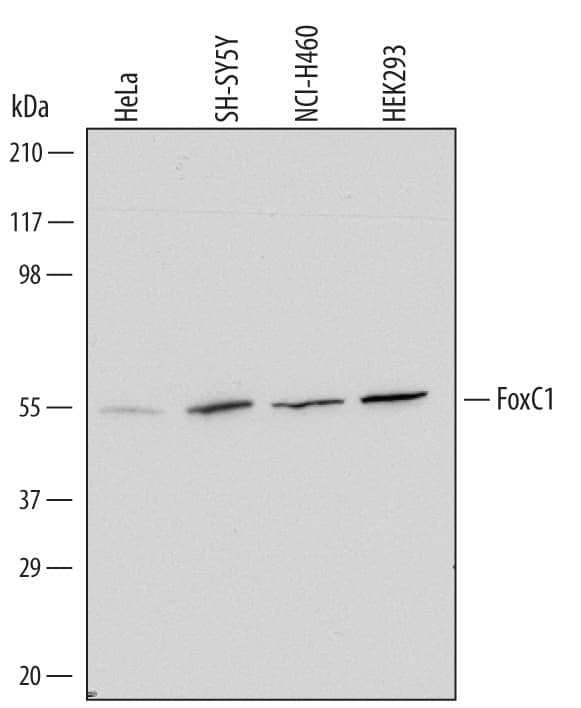Human FoxC1 Antibody
R&D Systems, part of Bio-Techne | Catalog # MAB6329

Key Product Details
Species Reactivity
Validated:
Cited:
Applications
Validated:
Cited:
Label
Antibody Source
Product Specifications
Immunogen
Gln208-Gln322
Accession # Q12948
Specificity
Clonality
Host
Isotype
Scientific Data Images for Human FoxC1 Antibody
Detection of Human FoxC1 by Western Blot.
Western blot shows lysates of HeLa human cervical epithelial carcinoma cell line, SH-SY5Y human neuroblastoma cell line, NCI-H460 human large cell lung carcinoma cell line, and HEK293 human embryonic kidney cell line. PVDF Membrane was probed with 1 µg/mL of Mouse Anti-Human FoxC1 Monoclonal Antibody (Catalog # MAB6329) followed by HRP-conjugated Anti-Mouse IgG Secondary Antibody (Catalog # HAF007). A specific band was detected for FoxC1 at approximately 60 kDa (as indicated). This experiment was conducted under reducing conditions and using Immunoblot Buffer Group 2.Applications for Human FoxC1 Antibody
Western Blot
Sample: HeLa human cervical epithelial carcinoma cell line, SH‑SY5Y human neuroblastoma cell line, NCI‑H460 human large cell lung carcinoma cell line, and HEK293 human embryonic kidney cell line
Formulation, Preparation, and Storage
Purification
Reconstitution
Formulation
Shipping
Stability & Storage
- 12 months from date of receipt, -20 to -70 °C as supplied.
- 1 month, 2 to 8 °C under sterile conditions after reconstitution.
- 6 months, -20 to -70 °C under sterile conditions after reconstitution.
Background: FoxC1
Human FoxC1 (forkhead box C1), also called FKHL7 (forkhead-like 7) or FREAC3 (forkhead-related activator 3) is a 553 amino acid (aa) intracellular phosphoprotein that belongs to a large family of nuclear transcription factors that share a common forkhead/winged helix DNA binding domain. FoxC1 is essential for formation of mesodermal tissues; mutations underlie Axenfeld-Rieger malformations of the eye. The human FoxC1 sequence includes a DNA binding domain at aa 77‑168 and an inhibitory domain between aa 268‑245. Phosphorylation within this inhibitory region causes a protein gel mobility shift. Human FoxC1 shares 92% and 91% aa identity with mouse and rat FoxC1, respectively.
Long Name
Alternate Names
Gene Symbol
UniProt
Additional FoxC1 Products
Product Documents for Human FoxC1 Antibody
Product Specific Notices for Human FoxC1 Antibody
For research use only
